Analyzing VADs IT Company's Approach to Entering Foreign Markets
VerifiedAdded on 2020/02/24
|15
|3714
|34
Report
AI Summary
This report provides a comprehensive analysis of VADs IT Company's strategies for entering foreign markets, with a particular focus on the Chinese market. It begins by outlining the theoretical frameworks, including the theory of competitive advantage and the factor endowment theory, that guide international business decisions. The report then explores various market entry models, such as direct and indirect exporting, foreign direct investment, licensing, franchising, and joint ventures, highlighting the strategic alliances that VADs IT Company employs to expand its global presence. The report also assesses the potential risks associated with operating in foreign markets, including political and economic instability, government regulations, labor market challenges, cultural differences, and currency fluctuations. Finally, it provides recommendations for VADs IT Company to achieve a competitive advantage in China, considering management responses and strategies to mitigate identified risks and optimize market entry strategies.

Business 1
Name
Institution
Course
Tutor
City/ State
Date
Name
Institution
Course
Tutor
City/ State
Date
Paraphrase This Document
Need a fresh take? Get an instant paraphrase of this document with our AI Paraphraser
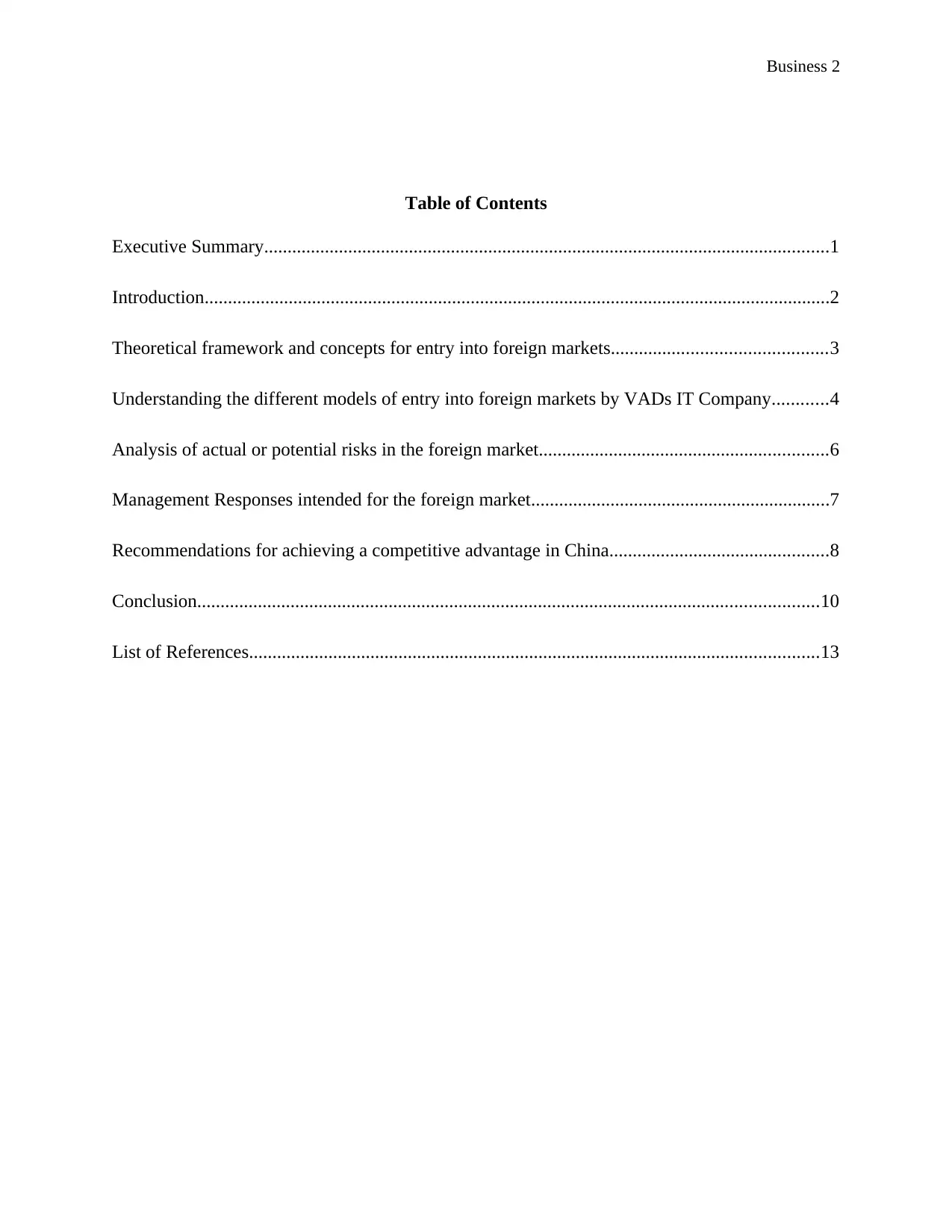
Business 2
Table of Contents
Executive Summary.........................................................................................................................1
Introduction......................................................................................................................................2
Theoretical framework and concepts for entry into foreign markets..............................................3
Understanding the different models of entry into foreign markets by VADs IT Company............4
Analysis of actual or potential risks in the foreign market..............................................................6
Management Responses intended for the foreign market................................................................7
Recommendations for achieving a competitive advantage in China...............................................8
Conclusion.....................................................................................................................................10
List of References..........................................................................................................................13
Table of Contents
Executive Summary.........................................................................................................................1
Introduction......................................................................................................................................2
Theoretical framework and concepts for entry into foreign markets..............................................3
Understanding the different models of entry into foreign markets by VADs IT Company............4
Analysis of actual or potential risks in the foreign market..............................................................6
Management Responses intended for the foreign market................................................................7
Recommendations for achieving a competitive advantage in China...............................................8
Conclusion.....................................................................................................................................10
List of References..........................................................................................................................13
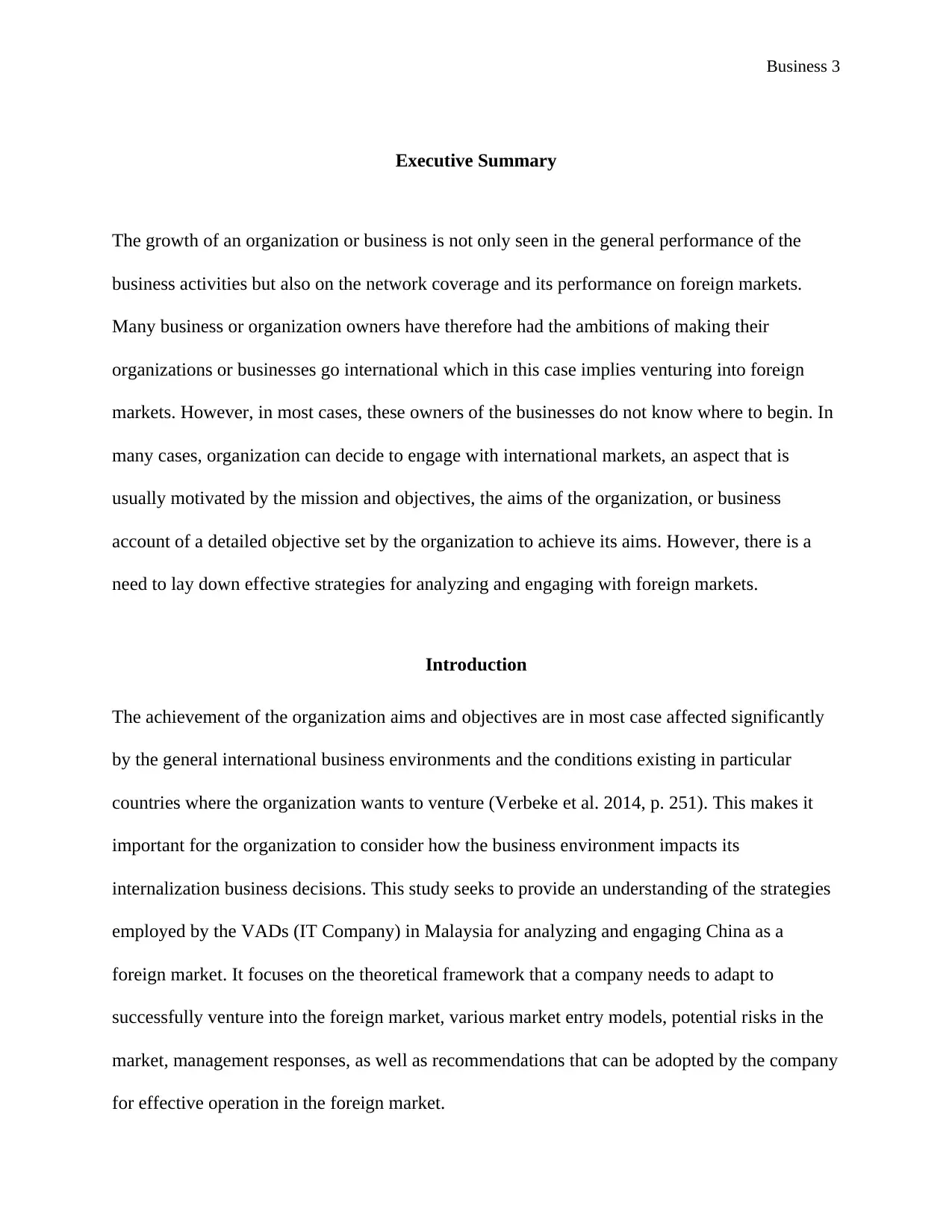
Business 3
Executive Summary
The growth of an organization or business is not only seen in the general performance of the
business activities but also on the network coverage and its performance on foreign markets.
Many business or organization owners have therefore had the ambitions of making their
organizations or businesses go international which in this case implies venturing into foreign
markets. However, in most cases, these owners of the businesses do not know where to begin. In
many cases, organization can decide to engage with international markets, an aspect that is
usually motivated by the mission and objectives, the aims of the organization, or business
account of a detailed objective set by the organization to achieve its aims. However, there is a
need to lay down effective strategies for analyzing and engaging with foreign markets.
Introduction
The achievement of the organization aims and objectives are in most case affected significantly
by the general international business environments and the conditions existing in particular
countries where the organization wants to venture (Verbeke et al. 2014, p. 251). This makes it
important for the organization to consider how the business environment impacts its
internalization business decisions. This study seeks to provide an understanding of the strategies
employed by the VADs (IT Company) in Malaysia for analyzing and engaging China as a
foreign market. It focuses on the theoretical framework that a company needs to adapt to
successfully venture into the foreign market, various market entry models, potential risks in the
market, management responses, as well as recommendations that can be adopted by the company
for effective operation in the foreign market.
Executive Summary
The growth of an organization or business is not only seen in the general performance of the
business activities but also on the network coverage and its performance on foreign markets.
Many business or organization owners have therefore had the ambitions of making their
organizations or businesses go international which in this case implies venturing into foreign
markets. However, in most cases, these owners of the businesses do not know where to begin. In
many cases, organization can decide to engage with international markets, an aspect that is
usually motivated by the mission and objectives, the aims of the organization, or business
account of a detailed objective set by the organization to achieve its aims. However, there is a
need to lay down effective strategies for analyzing and engaging with foreign markets.
Introduction
The achievement of the organization aims and objectives are in most case affected significantly
by the general international business environments and the conditions existing in particular
countries where the organization wants to venture (Verbeke et al. 2014, p. 251). This makes it
important for the organization to consider how the business environment impacts its
internalization business decisions. This study seeks to provide an understanding of the strategies
employed by the VADs (IT Company) in Malaysia for analyzing and engaging China as a
foreign market. It focuses on the theoretical framework that a company needs to adapt to
successfully venture into the foreign market, various market entry models, potential risks in the
market, management responses, as well as recommendations that can be adopted by the company
for effective operation in the foreign market.
⊘ This is a preview!⊘
Do you want full access?
Subscribe today to unlock all pages.

Trusted by 1+ million students worldwide
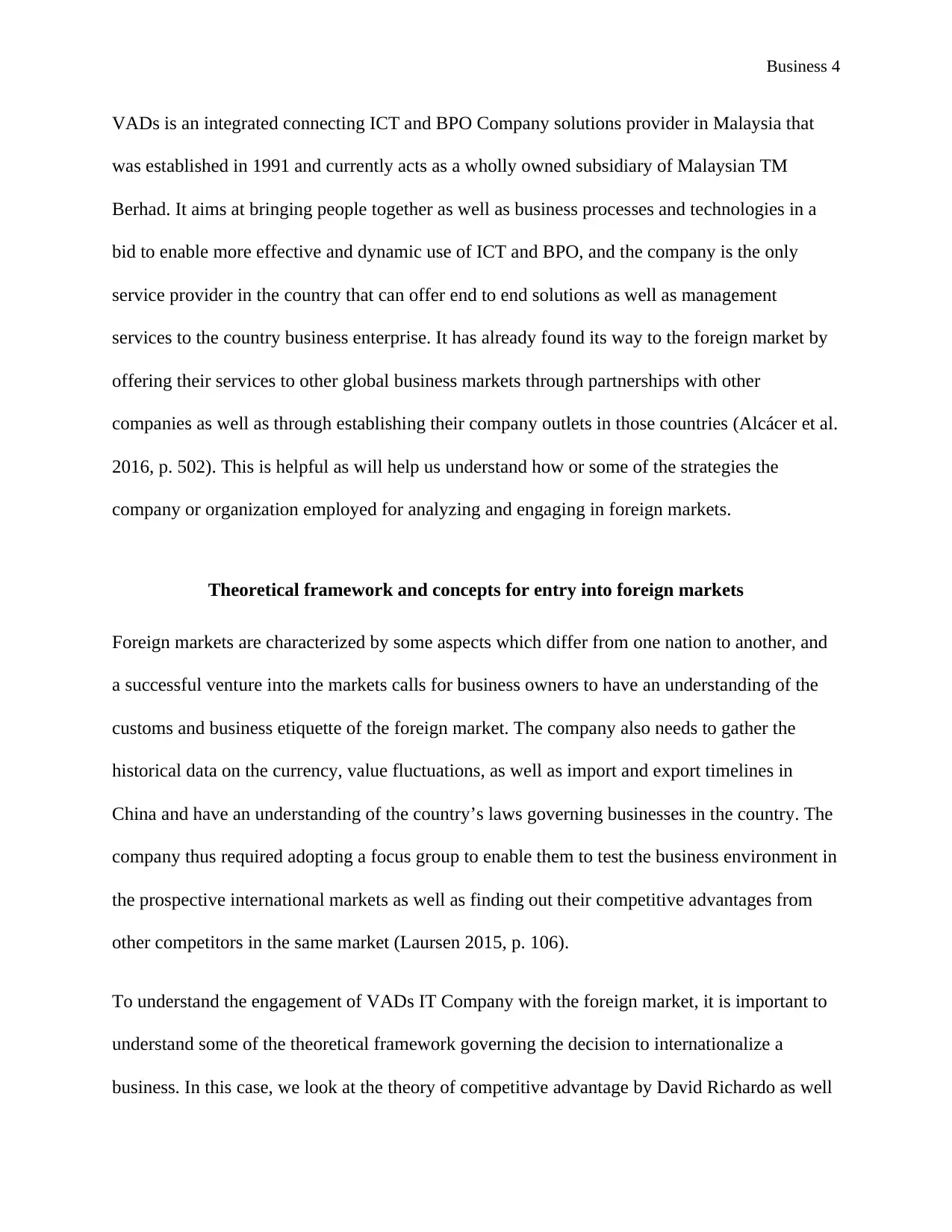
Business 4
VADs is an integrated connecting ICT and BPO Company solutions provider in Malaysia that
was established in 1991 and currently acts as a wholly owned subsidiary of Malaysian TM
Berhad. It aims at bringing people together as well as business processes and technologies in a
bid to enable more effective and dynamic use of ICT and BPO, and the company is the only
service provider in the country that can offer end to end solutions as well as management
services to the country business enterprise. It has already found its way to the foreign market by
offering their services to other global business markets through partnerships with other
companies as well as through establishing their company outlets in those countries (Alcácer et al.
2016, p. 502). This is helpful as will help us understand how or some of the strategies the
company or organization employed for analyzing and engaging in foreign markets.
Theoretical framework and concepts for entry into foreign markets
Foreign markets are characterized by some aspects which differ from one nation to another, and
a successful venture into the markets calls for business owners to have an understanding of the
customs and business etiquette of the foreign market. The company also needs to gather the
historical data on the currency, value fluctuations, as well as import and export timelines in
China and have an understanding of the country’s laws governing businesses in the country. The
company thus required adopting a focus group to enable them to test the business environment in
the prospective international markets as well as finding out their competitive advantages from
other competitors in the same market (Laursen 2015, p. 106).
To understand the engagement of VADs IT Company with the foreign market, it is important to
understand some of the theoretical framework governing the decision to internationalize a
business. In this case, we look at the theory of competitive advantage by David Richardo as well
VADs is an integrated connecting ICT and BPO Company solutions provider in Malaysia that
was established in 1991 and currently acts as a wholly owned subsidiary of Malaysian TM
Berhad. It aims at bringing people together as well as business processes and technologies in a
bid to enable more effective and dynamic use of ICT and BPO, and the company is the only
service provider in the country that can offer end to end solutions as well as management
services to the country business enterprise. It has already found its way to the foreign market by
offering their services to other global business markets through partnerships with other
companies as well as through establishing their company outlets in those countries (Alcácer et al.
2016, p. 502). This is helpful as will help us understand how or some of the strategies the
company or organization employed for analyzing and engaging in foreign markets.
Theoretical framework and concepts for entry into foreign markets
Foreign markets are characterized by some aspects which differ from one nation to another, and
a successful venture into the markets calls for business owners to have an understanding of the
customs and business etiquette of the foreign market. The company also needs to gather the
historical data on the currency, value fluctuations, as well as import and export timelines in
China and have an understanding of the country’s laws governing businesses in the country. The
company thus required adopting a focus group to enable them to test the business environment in
the prospective international markets as well as finding out their competitive advantages from
other competitors in the same market (Laursen 2015, p. 106).
To understand the engagement of VADs IT Company with the foreign market, it is important to
understand some of the theoretical framework governing the decision to internationalize a
business. In this case, we look at the theory of competitive advantage by David Richardo as well
Paraphrase This Document
Need a fresh take? Get an instant paraphrase of this document with our AI Paraphraser
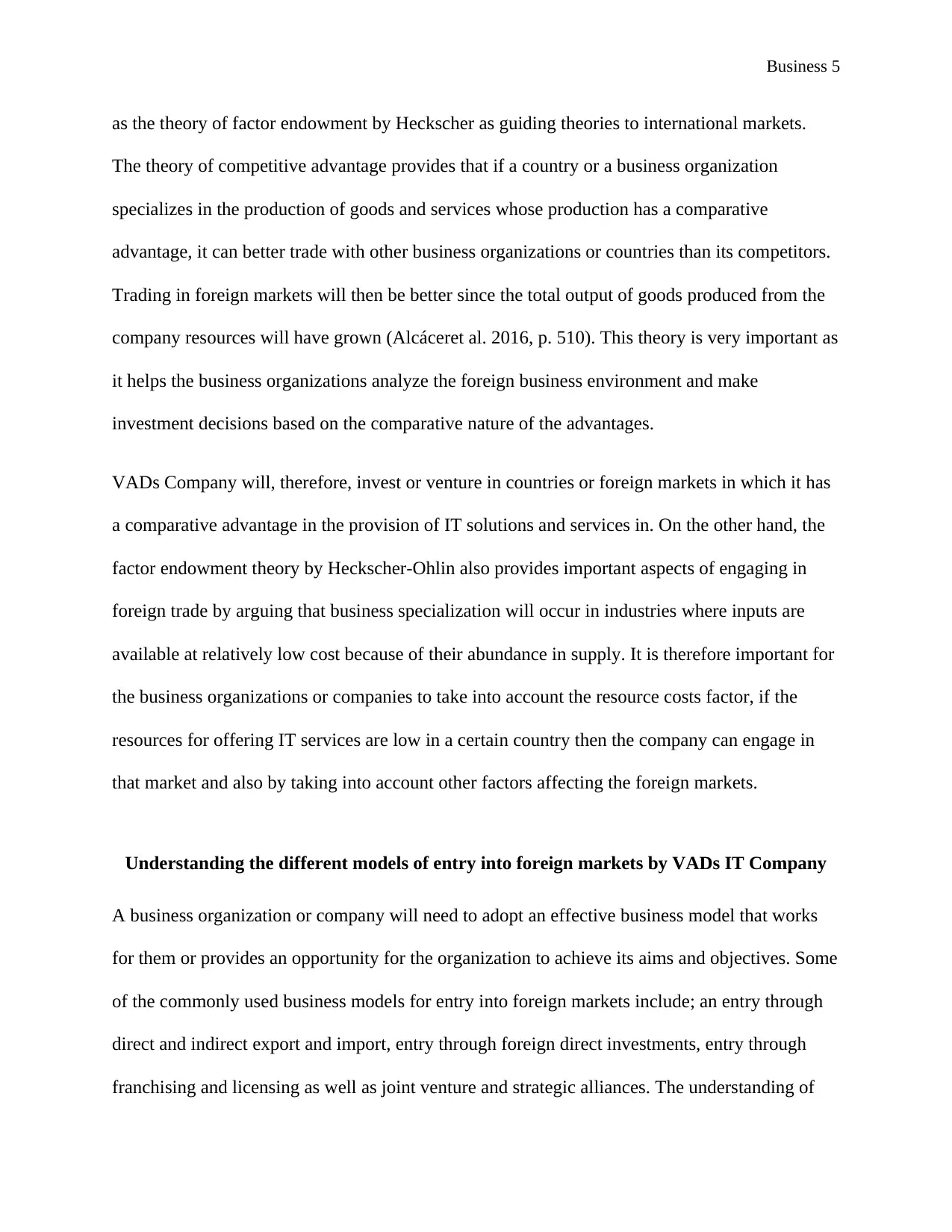
Business 5
as the theory of factor endowment by Heckscher as guiding theories to international markets.
The theory of competitive advantage provides that if a country or a business organization
specializes in the production of goods and services whose production has a comparative
advantage, it can better trade with other business organizations or countries than its competitors.
Trading in foreign markets will then be better since the total output of goods produced from the
company resources will have grown (Alcáceret al. 2016, p. 510). This theory is very important as
it helps the business organizations analyze the foreign business environment and make
investment decisions based on the comparative nature of the advantages.
VADs Company will, therefore, invest or venture in countries or foreign markets in which it has
a comparative advantage in the provision of IT solutions and services in. On the other hand, the
factor endowment theory by Heckscher-Ohlin also provides important aspects of engaging in
foreign trade by arguing that business specialization will occur in industries where inputs are
available at relatively low cost because of their abundance in supply. It is therefore important for
the business organizations or companies to take into account the resource costs factor, if the
resources for offering IT services are low in a certain country then the company can engage in
that market and also by taking into account other factors affecting the foreign markets.
Understanding the different models of entry into foreign markets by VADs IT Company
A business organization or company will need to adopt an effective business model that works
for them or provides an opportunity for the organization to achieve its aims and objectives. Some
of the commonly used business models for entry into foreign markets include; an entry through
direct and indirect export and import, entry through foreign direct investments, entry through
franchising and licensing as well as joint venture and strategic alliances. The understanding of
as the theory of factor endowment by Heckscher as guiding theories to international markets.
The theory of competitive advantage provides that if a country or a business organization
specializes in the production of goods and services whose production has a comparative
advantage, it can better trade with other business organizations or countries than its competitors.
Trading in foreign markets will then be better since the total output of goods produced from the
company resources will have grown (Alcáceret al. 2016, p. 510). This theory is very important as
it helps the business organizations analyze the foreign business environment and make
investment decisions based on the comparative nature of the advantages.
VADs Company will, therefore, invest or venture in countries or foreign markets in which it has
a comparative advantage in the provision of IT solutions and services in. On the other hand, the
factor endowment theory by Heckscher-Ohlin also provides important aspects of engaging in
foreign trade by arguing that business specialization will occur in industries where inputs are
available at relatively low cost because of their abundance in supply. It is therefore important for
the business organizations or companies to take into account the resource costs factor, if the
resources for offering IT services are low in a certain country then the company can engage in
that market and also by taking into account other factors affecting the foreign markets.
Understanding the different models of entry into foreign markets by VADs IT Company
A business organization or company will need to adopt an effective business model that works
for them or provides an opportunity for the organization to achieve its aims and objectives. Some
of the commonly used business models for entry into foreign markets include; an entry through
direct and indirect export and import, entry through foreign direct investments, entry through
franchising and licensing as well as joint venture and strategic alliances. The understanding of
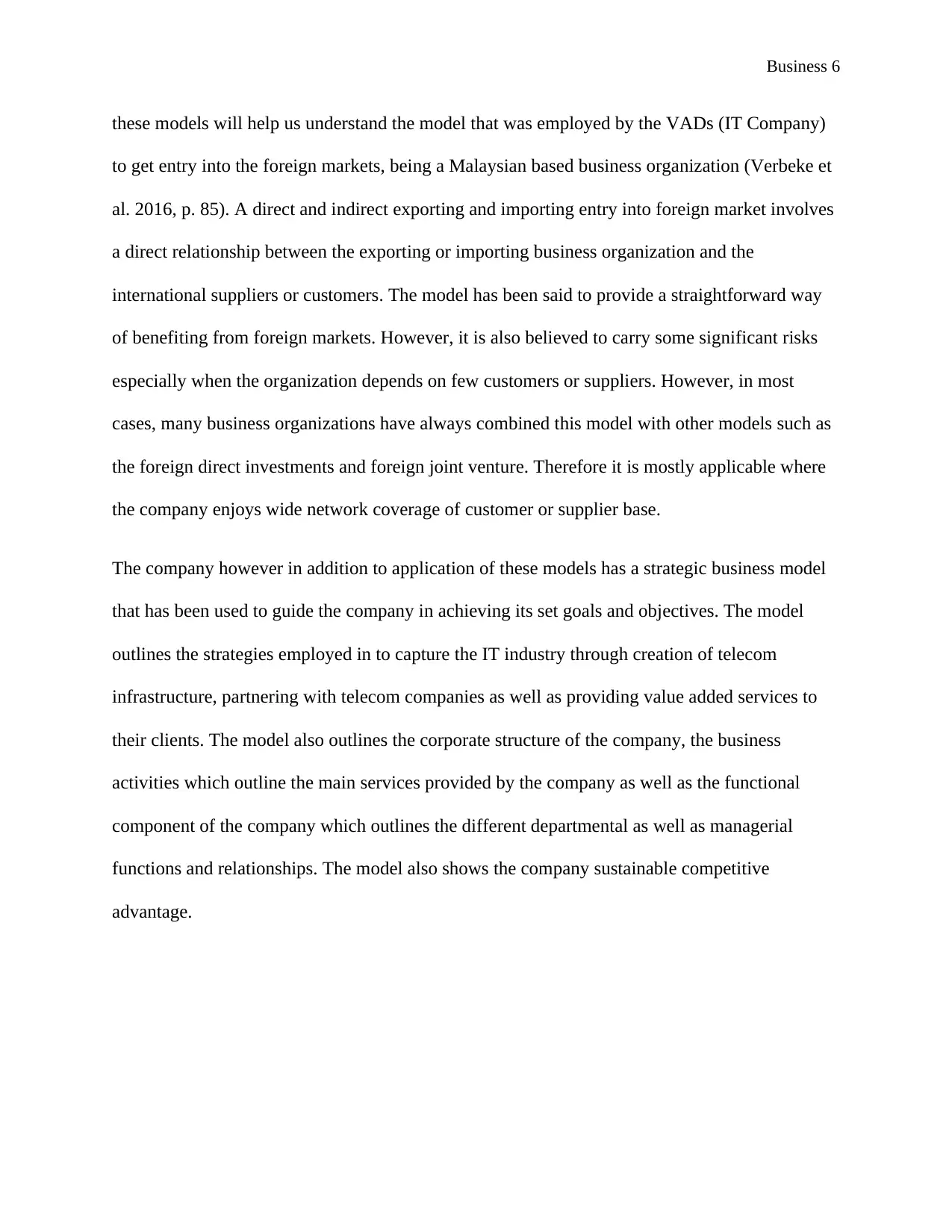
Business 6
these models will help us understand the model that was employed by the VADs (IT Company)
to get entry into the foreign markets, being a Malaysian based business organization (Verbeke et
al. 2016, p. 85). A direct and indirect exporting and importing entry into foreign market involves
a direct relationship between the exporting or importing business organization and the
international suppliers or customers. The model has been said to provide a straightforward way
of benefiting from foreign markets. However, it is also believed to carry some significant risks
especially when the organization depends on few customers or suppliers. However, in most
cases, many business organizations have always combined this model with other models such as
the foreign direct investments and foreign joint venture. Therefore it is mostly applicable where
the company enjoys wide network coverage of customer or supplier base.
The company however in addition to application of these models has a strategic business model
that has been used to guide the company in achieving its set goals and objectives. The model
outlines the strategies employed in to capture the IT industry through creation of telecom
infrastructure, partnering with telecom companies as well as providing value added services to
their clients. The model also outlines the corporate structure of the company, the business
activities which outline the main services provided by the company as well as the functional
component of the company which outlines the different departmental as well as managerial
functions and relationships. The model also shows the company sustainable competitive
advantage.
these models will help us understand the model that was employed by the VADs (IT Company)
to get entry into the foreign markets, being a Malaysian based business organization (Verbeke et
al. 2016, p. 85). A direct and indirect exporting and importing entry into foreign market involves
a direct relationship between the exporting or importing business organization and the
international suppliers or customers. The model has been said to provide a straightforward way
of benefiting from foreign markets. However, it is also believed to carry some significant risks
especially when the organization depends on few customers or suppliers. However, in most
cases, many business organizations have always combined this model with other models such as
the foreign direct investments and foreign joint venture. Therefore it is mostly applicable where
the company enjoys wide network coverage of customer or supplier base.
The company however in addition to application of these models has a strategic business model
that has been used to guide the company in achieving its set goals and objectives. The model
outlines the strategies employed in to capture the IT industry through creation of telecom
infrastructure, partnering with telecom companies as well as providing value added services to
their clients. The model also outlines the corporate structure of the company, the business
activities which outline the main services provided by the company as well as the functional
component of the company which outlines the different departmental as well as managerial
functions and relationships. The model also shows the company sustainable competitive
advantage.
⊘ This is a preview!⊘
Do you want full access?
Subscribe today to unlock all pages.

Trusted by 1+ million students worldwide
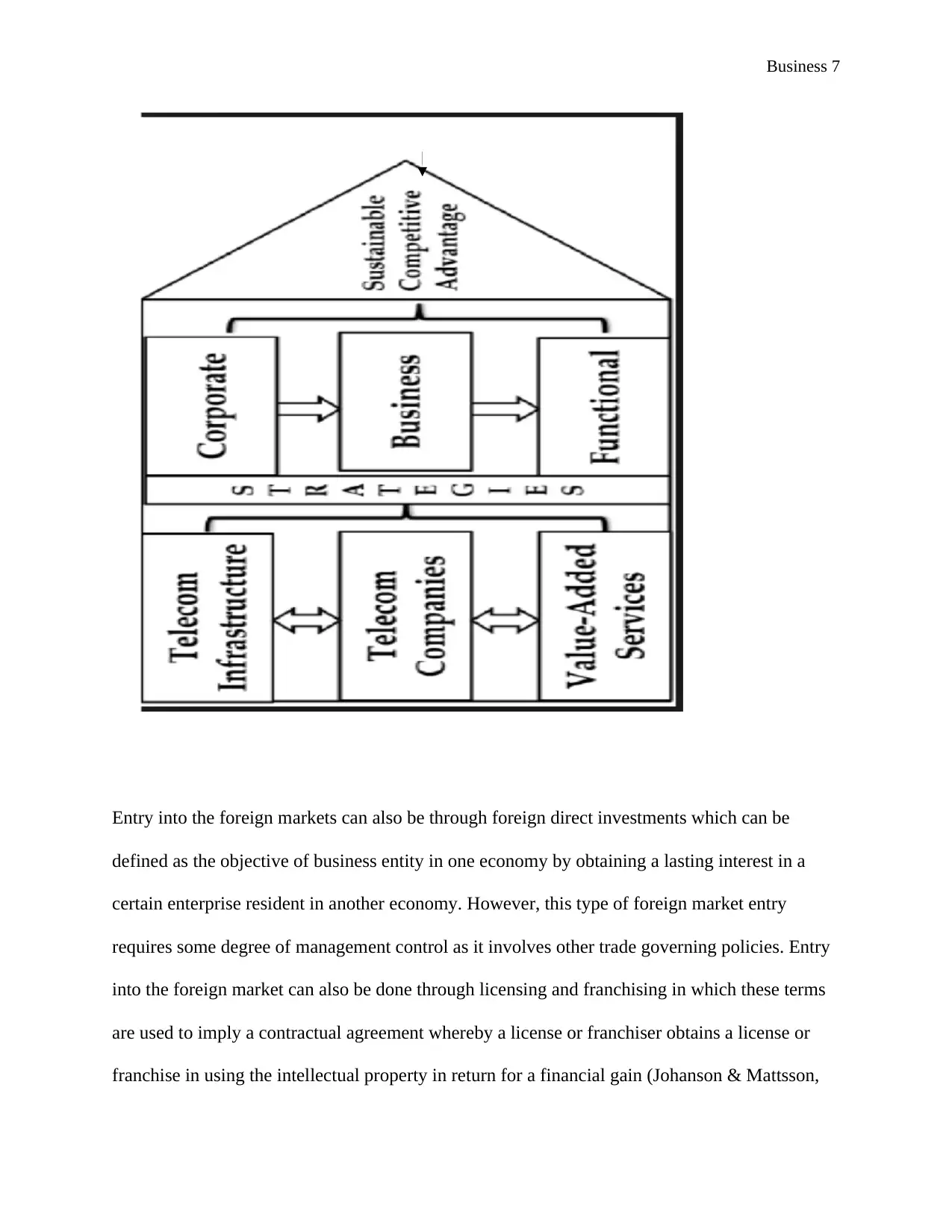
Business 7
Entry into the foreign markets can also be through foreign direct investments which can be
defined as the objective of business entity in one economy by obtaining a lasting interest in a
certain enterprise resident in another economy. However, this type of foreign market entry
requires some degree of management control as it involves other trade governing policies. Entry
into the foreign market can also be done through licensing and franchising in which these terms
are used to imply a contractual agreement whereby a license or franchiser obtains a license or
franchise in using the intellectual property in return for a financial gain (Johanson & Mattsson,
Entry into the foreign markets can also be through foreign direct investments which can be
defined as the objective of business entity in one economy by obtaining a lasting interest in a
certain enterprise resident in another economy. However, this type of foreign market entry
requires some degree of management control as it involves other trade governing policies. Entry
into the foreign market can also be done through licensing and franchising in which these terms
are used to imply a contractual agreement whereby a license or franchiser obtains a license or
franchise in using the intellectual property in return for a financial gain (Johanson & Mattsson,
Paraphrase This Document
Need a fresh take? Get an instant paraphrase of this document with our AI Paraphraser
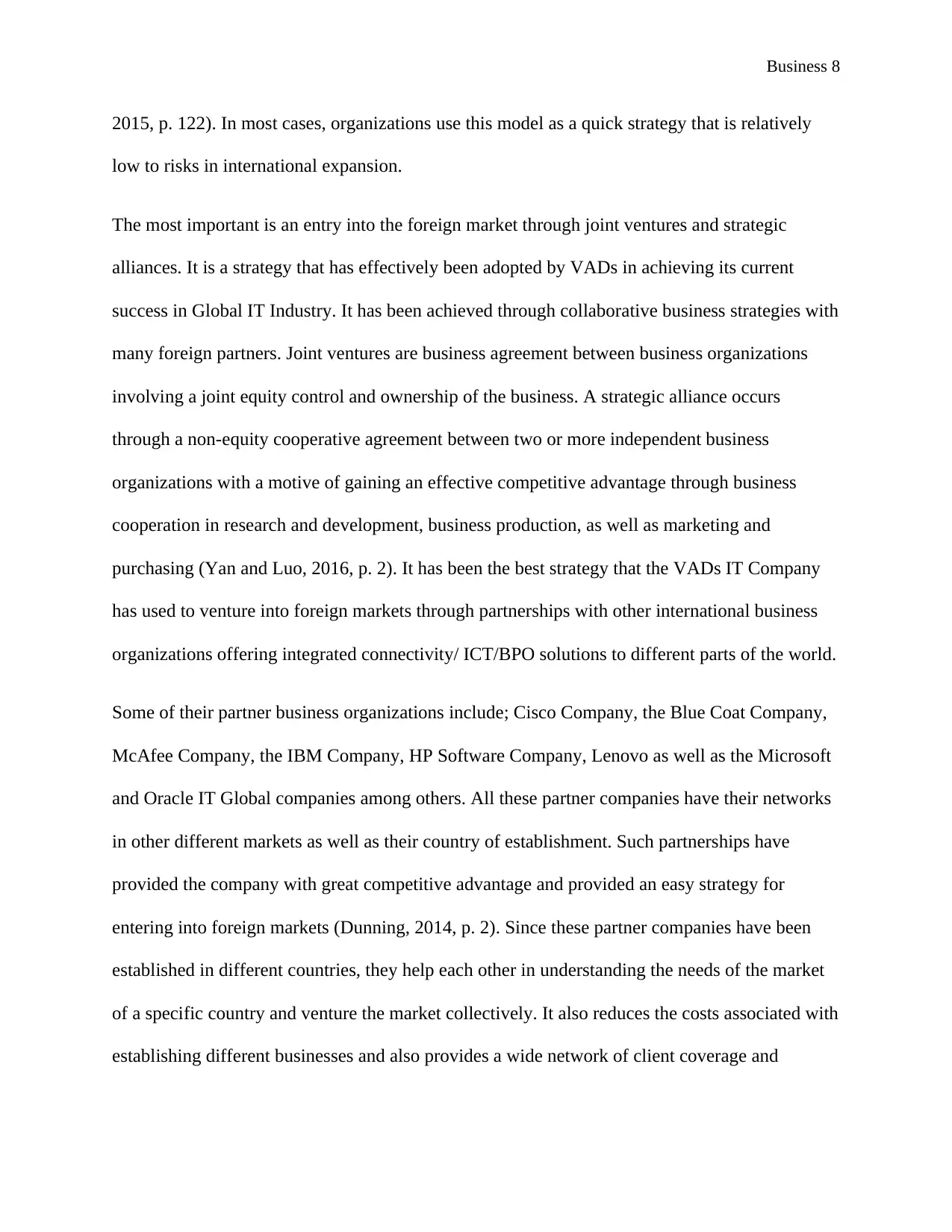
Business 8
2015, p. 122). In most cases, organizations use this model as a quick strategy that is relatively
low to risks in international expansion.
The most important is an entry into the foreign market through joint ventures and strategic
alliances. It is a strategy that has effectively been adopted by VADs in achieving its current
success in Global IT Industry. It has been achieved through collaborative business strategies with
many foreign partners. Joint ventures are business agreement between business organizations
involving a joint equity control and ownership of the business. A strategic alliance occurs
through a non-equity cooperative agreement between two or more independent business
organizations with a motive of gaining an effective competitive advantage through business
cooperation in research and development, business production, as well as marketing and
purchasing (Yan and Luo, 2016, p. 2). It has been the best strategy that the VADs IT Company
has used to venture into foreign markets through partnerships with other international business
organizations offering integrated connectivity/ ICT/BPO solutions to different parts of the world.
Some of their partner business organizations include; Cisco Company, the Blue Coat Company,
McAfee Company, the IBM Company, HP Software Company, Lenovo as well as the Microsoft
and Oracle IT Global companies among others. All these partner companies have their networks
in other different markets as well as their country of establishment. Such partnerships have
provided the company with great competitive advantage and provided an easy strategy for
entering into foreign markets (Dunning, 2014, p. 2). Since these partner companies have been
established in different countries, they help each other in understanding the needs of the market
of a specific country and venture the market collectively. It also reduces the costs associated with
establishing different businesses and also provides a wide network of client coverage and
2015, p. 122). In most cases, organizations use this model as a quick strategy that is relatively
low to risks in international expansion.
The most important is an entry into the foreign market through joint ventures and strategic
alliances. It is a strategy that has effectively been adopted by VADs in achieving its current
success in Global IT Industry. It has been achieved through collaborative business strategies with
many foreign partners. Joint ventures are business agreement between business organizations
involving a joint equity control and ownership of the business. A strategic alliance occurs
through a non-equity cooperative agreement between two or more independent business
organizations with a motive of gaining an effective competitive advantage through business
cooperation in research and development, business production, as well as marketing and
purchasing (Yan and Luo, 2016, p. 2). It has been the best strategy that the VADs IT Company
has used to venture into foreign markets through partnerships with other international business
organizations offering integrated connectivity/ ICT/BPO solutions to different parts of the world.
Some of their partner business organizations include; Cisco Company, the Blue Coat Company,
McAfee Company, the IBM Company, HP Software Company, Lenovo as well as the Microsoft
and Oracle IT Global companies among others. All these partner companies have their networks
in other different markets as well as their country of establishment. Such partnerships have
provided the company with great competitive advantage and provided an easy strategy for
entering into foreign markets (Dunning, 2014, p. 2). Since these partner companies have been
established in different countries, they help each other in understanding the needs of the market
of a specific country and venture the market collectively. It also reduces the costs associated with
establishing different businesses and also provides a wide network of client coverage and
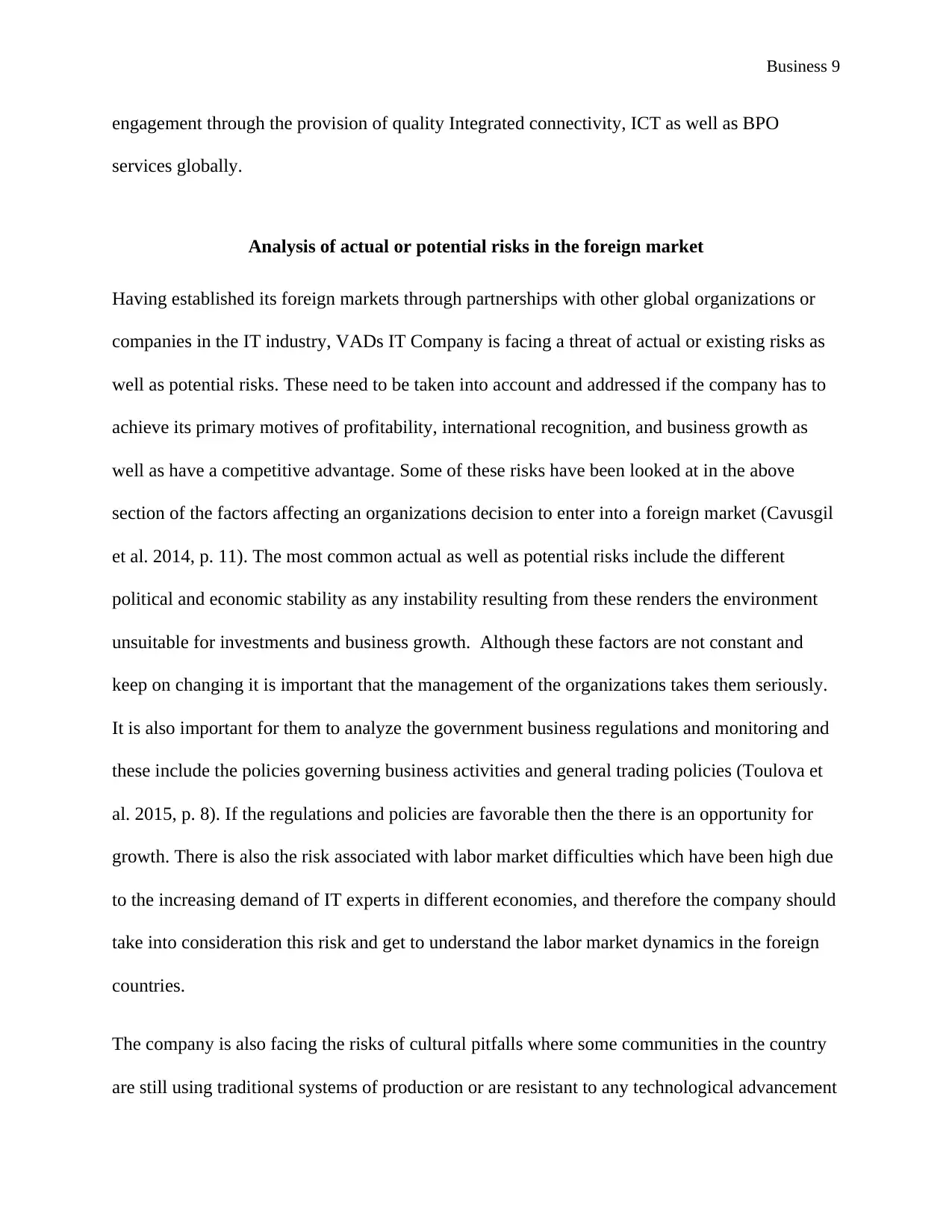
Business 9
engagement through the provision of quality Integrated connectivity, ICT as well as BPO
services globally.
Analysis of actual or potential risks in the foreign market
Having established its foreign markets through partnerships with other global organizations or
companies in the IT industry, VADs IT Company is facing a threat of actual or existing risks as
well as potential risks. These need to be taken into account and addressed if the company has to
achieve its primary motives of profitability, international recognition, and business growth as
well as have a competitive advantage. Some of these risks have been looked at in the above
section of the factors affecting an organizations decision to enter into a foreign market (Cavusgil
et al. 2014, p. 11). The most common actual as well as potential risks include the different
political and economic stability as any instability resulting from these renders the environment
unsuitable for investments and business growth. Although these factors are not constant and
keep on changing it is important that the management of the organizations takes them seriously.
It is also important for them to analyze the government business regulations and monitoring and
these include the policies governing business activities and general trading policies (Toulova et
al. 2015, p. 8). If the regulations and policies are favorable then the there is an opportunity for
growth. There is also the risk associated with labor market difficulties which have been high due
to the increasing demand of IT experts in different economies, and therefore the company should
take into consideration this risk and get to understand the labor market dynamics in the foreign
countries.
The company is also facing the risks of cultural pitfalls where some communities in the country
are still using traditional systems of production or are resistant to any technological advancement
engagement through the provision of quality Integrated connectivity, ICT as well as BPO
services globally.
Analysis of actual or potential risks in the foreign market
Having established its foreign markets through partnerships with other global organizations or
companies in the IT industry, VADs IT Company is facing a threat of actual or existing risks as
well as potential risks. These need to be taken into account and addressed if the company has to
achieve its primary motives of profitability, international recognition, and business growth as
well as have a competitive advantage. Some of these risks have been looked at in the above
section of the factors affecting an organizations decision to enter into a foreign market (Cavusgil
et al. 2014, p. 11). The most common actual as well as potential risks include the different
political and economic stability as any instability resulting from these renders the environment
unsuitable for investments and business growth. Although these factors are not constant and
keep on changing it is important that the management of the organizations takes them seriously.
It is also important for them to analyze the government business regulations and monitoring and
these include the policies governing business activities and general trading policies (Toulova et
al. 2015, p. 8). If the regulations and policies are favorable then the there is an opportunity for
growth. There is also the risk associated with labor market difficulties which have been high due
to the increasing demand of IT experts in different economies, and therefore the company should
take into consideration this risk and get to understand the labor market dynamics in the foreign
countries.
The company is also facing the risks of cultural pitfalls where some communities in the country
are still using traditional systems of production or are resistant to any technological advancement
⊘ This is a preview!⊘
Do you want full access?
Subscribe today to unlock all pages.

Trusted by 1+ million students worldwide
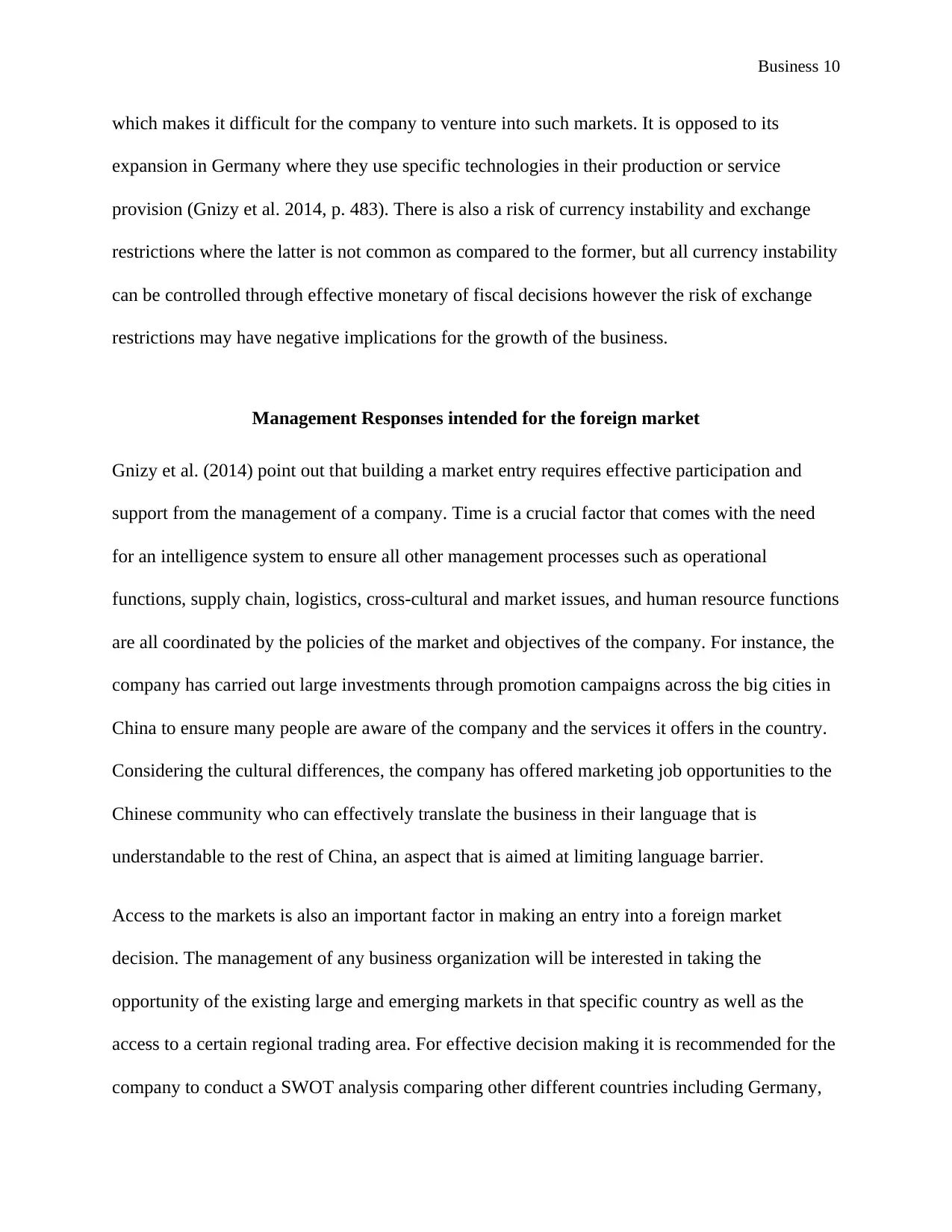
Business 10
which makes it difficult for the company to venture into such markets. It is opposed to its
expansion in Germany where they use specific technologies in their production or service
provision (Gnizy et al. 2014, p. 483). There is also a risk of currency instability and exchange
restrictions where the latter is not common as compared to the former, but all currency instability
can be controlled through effective monetary of fiscal decisions however the risk of exchange
restrictions may have negative implications for the growth of the business.
Management Responses intended for the foreign market
Gnizy et al. (2014) point out that building a market entry requires effective participation and
support from the management of a company. Time is a crucial factor that comes with the need
for an intelligence system to ensure all other management processes such as operational
functions, supply chain, logistics, cross-cultural and market issues, and human resource functions
are all coordinated by the policies of the market and objectives of the company. For instance, the
company has carried out large investments through promotion campaigns across the big cities in
China to ensure many people are aware of the company and the services it offers in the country.
Considering the cultural differences, the company has offered marketing job opportunities to the
Chinese community who can effectively translate the business in their language that is
understandable to the rest of China, an aspect that is aimed at limiting language barrier.
Access to the markets is also an important factor in making an entry into a foreign market
decision. The management of any business organization will be interested in taking the
opportunity of the existing large and emerging markets in that specific country as well as the
access to a certain regional trading area. For effective decision making it is recommended for the
company to conduct a SWOT analysis comparing other different countries including Germany,
which makes it difficult for the company to venture into such markets. It is opposed to its
expansion in Germany where they use specific technologies in their production or service
provision (Gnizy et al. 2014, p. 483). There is also a risk of currency instability and exchange
restrictions where the latter is not common as compared to the former, but all currency instability
can be controlled through effective monetary of fiscal decisions however the risk of exchange
restrictions may have negative implications for the growth of the business.
Management Responses intended for the foreign market
Gnizy et al. (2014) point out that building a market entry requires effective participation and
support from the management of a company. Time is a crucial factor that comes with the need
for an intelligence system to ensure all other management processes such as operational
functions, supply chain, logistics, cross-cultural and market issues, and human resource functions
are all coordinated by the policies of the market and objectives of the company. For instance, the
company has carried out large investments through promotion campaigns across the big cities in
China to ensure many people are aware of the company and the services it offers in the country.
Considering the cultural differences, the company has offered marketing job opportunities to the
Chinese community who can effectively translate the business in their language that is
understandable to the rest of China, an aspect that is aimed at limiting language barrier.
Access to the markets is also an important factor in making an entry into a foreign market
decision. The management of any business organization will be interested in taking the
opportunity of the existing large and emerging markets in that specific country as well as the
access to a certain regional trading area. For effective decision making it is recommended for the
company to conduct a SWOT analysis comparing other different countries including Germany,
Paraphrase This Document
Need a fresh take? Get an instant paraphrase of this document with our AI Paraphraser
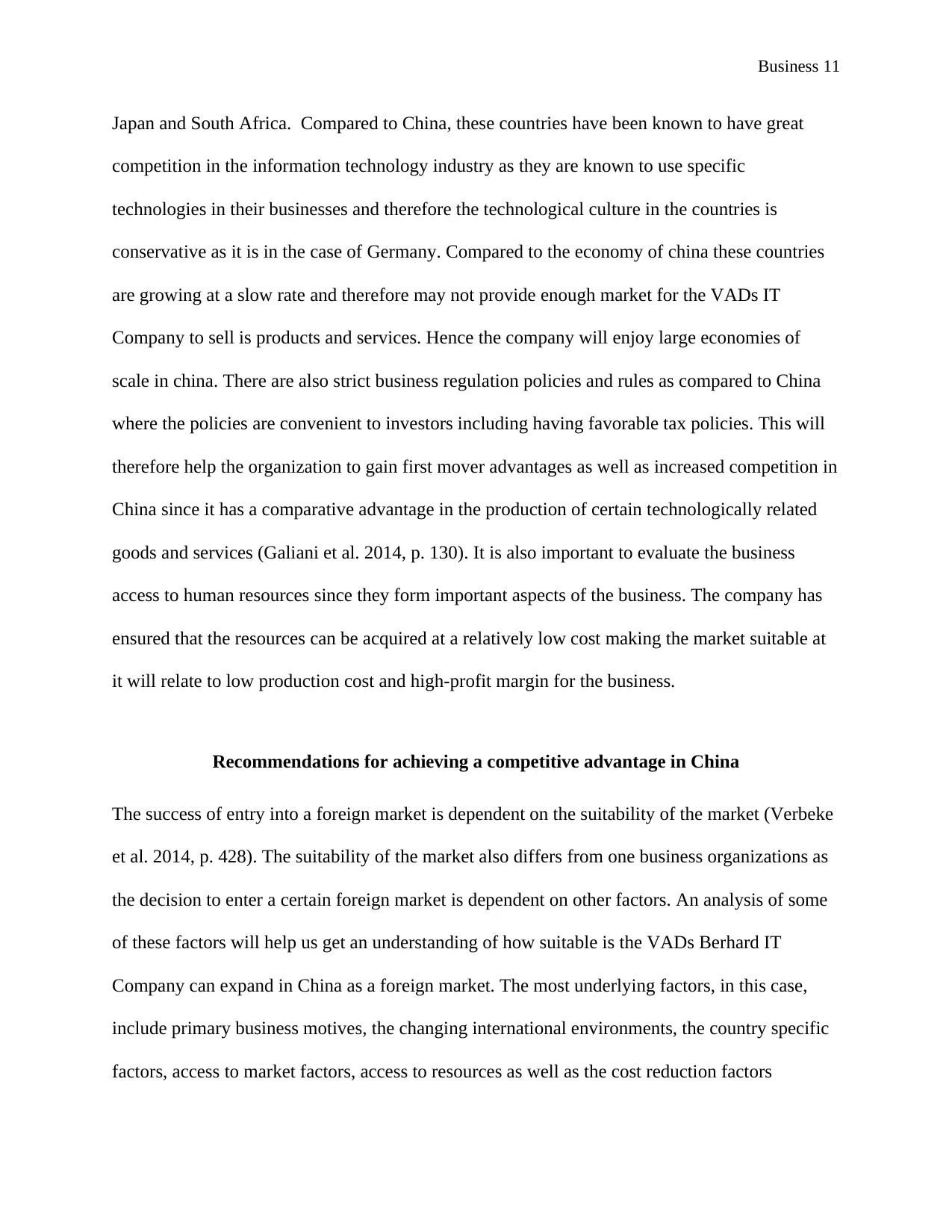
Business 11
Japan and South Africa. Compared to China, these countries have been known to have great
competition in the information technology industry as they are known to use specific
technologies in their businesses and therefore the technological culture in the countries is
conservative as it is in the case of Germany. Compared to the economy of china these countries
are growing at a slow rate and therefore may not provide enough market for the VADs IT
Company to sell is products and services. Hence the company will enjoy large economies of
scale in china. There are also strict business regulation policies and rules as compared to China
where the policies are convenient to investors including having favorable tax policies. This will
therefore help the organization to gain first mover advantages as well as increased competition in
China since it has a comparative advantage in the production of certain technologically related
goods and services (Galiani et al. 2014, p. 130). It is also important to evaluate the business
access to human resources since they form important aspects of the business. The company has
ensured that the resources can be acquired at a relatively low cost making the market suitable at
it will relate to low production cost and high-profit margin for the business.
Recommendations for achieving a competitive advantage in China
The success of entry into a foreign market is dependent on the suitability of the market (Verbeke
et al. 2014, p. 428). The suitability of the market also differs from one business organizations as
the decision to enter a certain foreign market is dependent on other factors. An analysis of some
of these factors will help us get an understanding of how suitable is the VADs Berhard IT
Company can expand in China as a foreign market. The most underlying factors, in this case,
include primary business motives, the changing international environments, the country specific
factors, access to market factors, access to resources as well as the cost reduction factors
Japan and South Africa. Compared to China, these countries have been known to have great
competition in the information technology industry as they are known to use specific
technologies in their businesses and therefore the technological culture in the countries is
conservative as it is in the case of Germany. Compared to the economy of china these countries
are growing at a slow rate and therefore may not provide enough market for the VADs IT
Company to sell is products and services. Hence the company will enjoy large economies of
scale in china. There are also strict business regulation policies and rules as compared to China
where the policies are convenient to investors including having favorable tax policies. This will
therefore help the organization to gain first mover advantages as well as increased competition in
China since it has a comparative advantage in the production of certain technologically related
goods and services (Galiani et al. 2014, p. 130). It is also important to evaluate the business
access to human resources since they form important aspects of the business. The company has
ensured that the resources can be acquired at a relatively low cost making the market suitable at
it will relate to low production cost and high-profit margin for the business.
Recommendations for achieving a competitive advantage in China
The success of entry into a foreign market is dependent on the suitability of the market (Verbeke
et al. 2014, p. 428). The suitability of the market also differs from one business organizations as
the decision to enter a certain foreign market is dependent on other factors. An analysis of some
of these factors will help us get an understanding of how suitable is the VADs Berhard IT
Company can expand in China as a foreign market. The most underlying factors, in this case,
include primary business motives, the changing international environments, the country specific
factors, access to market factors, access to resources as well as the cost reduction factors

Business 12
affecting the Chinese market. Every business organization is driven by certain primary motives
including profit making opportunities, business growth, attaining international recognition as
well as having a competitive advantage. The growth of the IT industry globally has increasingly
brought a lot of competition in economies by different companies which have called for effective
business strategies to succeed in China (Laursen, 2015, p. 110). Having a joint venture and
strategic alliances with the Chinese market can thus help the management of the VADS Berhad
IT Company to achieve growth, profitability, reduce operational costs as well as gain
international recognition.
It is also important for the company to understand the changing international environments by
looking into changes resulting from international states of China (Serrat, 2017, p. 640). It is
hence recommended for the company to evaluate issues concerning peace and stability, Chinese
economic growth in compassion to other emerging markets, increase or reduction in trade
barriers, and technological innovations in the country that can support the business. The process
will help the organization to prepare itself effectively by conducting a cost benefit analysis of the
market and taking appropriate measures. The assessment of Chinese economic growth will help
the company to develop effective future strategies for the future continuity of the business. It
should also understand the Chinese specific factors which may affect the entry into the foreign
markets which involve looking into a country political and economic stability, the culture and
business instructions, the supportive government policies as well as the absence of the nuisance
costs. If the political and economic environment of the country is stable, then the market is
suitable for investment whereas the market will also be suitable if the culture of the country as
well as of the business institution supports the use of IT in its business activities (Gnizy et al.
2014, p. 491). Favorable government policies such as tax reduction, removal of import and
affecting the Chinese market. Every business organization is driven by certain primary motives
including profit making opportunities, business growth, attaining international recognition as
well as having a competitive advantage. The growth of the IT industry globally has increasingly
brought a lot of competition in economies by different companies which have called for effective
business strategies to succeed in China (Laursen, 2015, p. 110). Having a joint venture and
strategic alliances with the Chinese market can thus help the management of the VADS Berhad
IT Company to achieve growth, profitability, reduce operational costs as well as gain
international recognition.
It is also important for the company to understand the changing international environments by
looking into changes resulting from international states of China (Serrat, 2017, p. 640). It is
hence recommended for the company to evaluate issues concerning peace and stability, Chinese
economic growth in compassion to other emerging markets, increase or reduction in trade
barriers, and technological innovations in the country that can support the business. The process
will help the organization to prepare itself effectively by conducting a cost benefit analysis of the
market and taking appropriate measures. The assessment of Chinese economic growth will help
the company to develop effective future strategies for the future continuity of the business. It
should also understand the Chinese specific factors which may affect the entry into the foreign
markets which involve looking into a country political and economic stability, the culture and
business instructions, the supportive government policies as well as the absence of the nuisance
costs. If the political and economic environment of the country is stable, then the market is
suitable for investment whereas the market will also be suitable if the culture of the country as
well as of the business institution supports the use of IT in its business activities (Gnizy et al.
2014, p. 491). Favorable government policies such as tax reduction, removal of import and
⊘ This is a preview!⊘
Do you want full access?
Subscribe today to unlock all pages.

Trusted by 1+ million students worldwide
1 out of 15
Related Documents
Your All-in-One AI-Powered Toolkit for Academic Success.
+13062052269
info@desklib.com
Available 24*7 on WhatsApp / Email
![[object Object]](/_next/static/media/star-bottom.7253800d.svg)
Unlock your academic potential
Copyright © 2020–2025 A2Z Services. All Rights Reserved. Developed and managed by ZUCOL.



